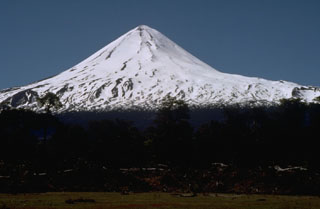Report on Llaima (Chile) — 8 April-14 April 2009
Smithsonian Institution / US Geological Survey
Weekly Volcanic Activity Report, 8 April-14 April 2009
Managing Editor: Sally Sennert.
Please cite this report as:
Global Volcanism Program, 2009. Report on Llaima (Chile) (Sennert, S, ed.). Weekly Volcanic Activity Report, 8 April-14 April 2009. Smithsonian Institution and US Geological Survey.
Llaima
Chile
38.692°S, 71.729°W; summit elev. 3125 m
All times are local (unless otherwise noted)
On 8 April, SERNAGEOMIN reported that, after 74 hours of a vigorous Strombolian eruption from Llaima and accompanying lava flow emissions, activity declined quickly on 6 April until reaching a low level characterized by small amounts of ash emissions. On 7 April, weak emissions of gas and ash were observed. An overflight revealed that the main crater was completely obscured by a large pyroclastic cone with four inactive craters. Sulfur dioxide and hydrochloric gasses were emitted. Two lava flows descended the W flank. The more southerly lava flow was about 4.5 km long and melted part of the glacier, causing a lahar to travel towards the Calbuco River. The more northerly lava flow was similar in length, and branched off into two 1-km-long flows. It too caused a lahar. On the NE flank, a lava flow that originated from the base of the pyroclastic cone caused lahars that descended into the valley between Curacautín (30 km NNW) and the Conguillío National Park.
During 7-10 April, intermittent incandescence from a lava flow at the SW base of the pyroclastic cone was observed. Incandescent blocks originating from the lava flow descended W. On 8 April, gasses emitted from multiple points on the pyroclastic cone formed a plume that drifted NE. Preliminary calculations indicated that the height of the pyroclastic cone exceeded the top of the main crater by 70 m, making the summit elevation 3,240 m a.s.l. During 9-10 and 13-14 April, gas and steam plumes rose from the pyroclastic cone; views were obscured by clouds on 11 and 12 April. On 14 April, fumarolic activity from the pyroclastic cone was again noted. The Volcano Alert Level remained at Red.
Geological Summary. Llaima, one of Chile's largest and most active volcanoes, contains two main historically active craters, one at the summit and the other, Pichillaima, to the SE. The massive, dominantly basaltic-to-andesitic, stratovolcano has a volume of 400 km3. A Holocene edifice built primarily of accumulated lava flows was constructed over an 8-km-wide caldera that formed about 13,200 years ago, following the eruption of the 24 km3 Curacautín Ignimbrite. More than 40 scoria cones dot the volcano's flanks. Following the end of an explosive stage about 7200 years ago, construction of the present edifice began, characterized by Strombolian, Hawaiian, and infrequent subplinian eruptions. Frequent moderate explosive eruptions with occasional lava flows have been recorded since the 17th century.
Source: Servicio Nacional de Geología y Minería (SERNAGEOMIN)

